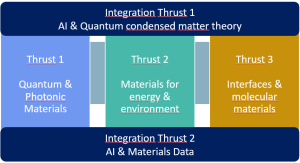The vision for the Institut Courtois is to promote an environment of creativity and discovery that will lead to fundamental breakthroughs in materials sciences. The Institute brings together leading researchers to accelerate materials research in five main thrusts, with two integrating and horizontal thrusts.

- Quantum materials and quantum photonics The objective is to enable breakthroughs in understanding highly correlated materials such as unconventional superconductors and topological insulators. We see an opportunity to focus on theoretical aspects and the commissioning of new optical probes to define unique activity in this field. With the emphasis on optical probes for quantum materials research, we also have opportunities to develop quantum optics techniques for probing complex materials. In addition, we will develop quantum optics platforms for the simulation of materials for quantum computing.
- Materials for energy and the environment. In this thrust, the focus will be the research on energy conversion (photovoltaics, ferroelectrics, piezoelectrics), energy storage (batteries), energy conservation (optoelectronics) and the environment (catalysis, pollution control). In general, these processes are out of equilibrium and can benefit greatly from artificial intelligence to control them.
- Development of molecular materials. Synthesis in autonomous laboratories, aided by artificial intelligence and robotic methods, is a central theme at the Institute. The vision of this axis is to go beyond the boundaries of matter in the context of the digitalization of materials science. The aim of this axis is to understand structure-shaping-property relationships with a view to controlling them more effectively. Synthesis, processing and the study of material properties will be the areas of expertise to be federated in order to achieve this objective.
- AI & Quantum condensed matter. In this AI4Science thrust, we aim to co-develop AI tools through quantum condensed matter theory, and then using the tools to predict materials with desired properties.
- AI in automation and materials data. In this thrust, AI tools are used to accelerate the characterization and data analysis of materials. It also includes large language models for data mining.